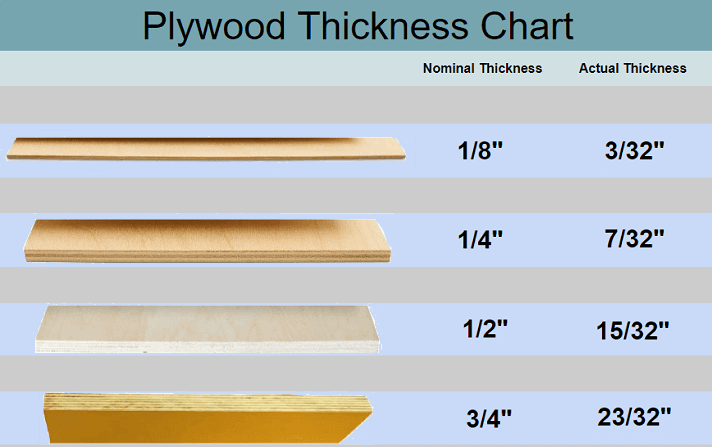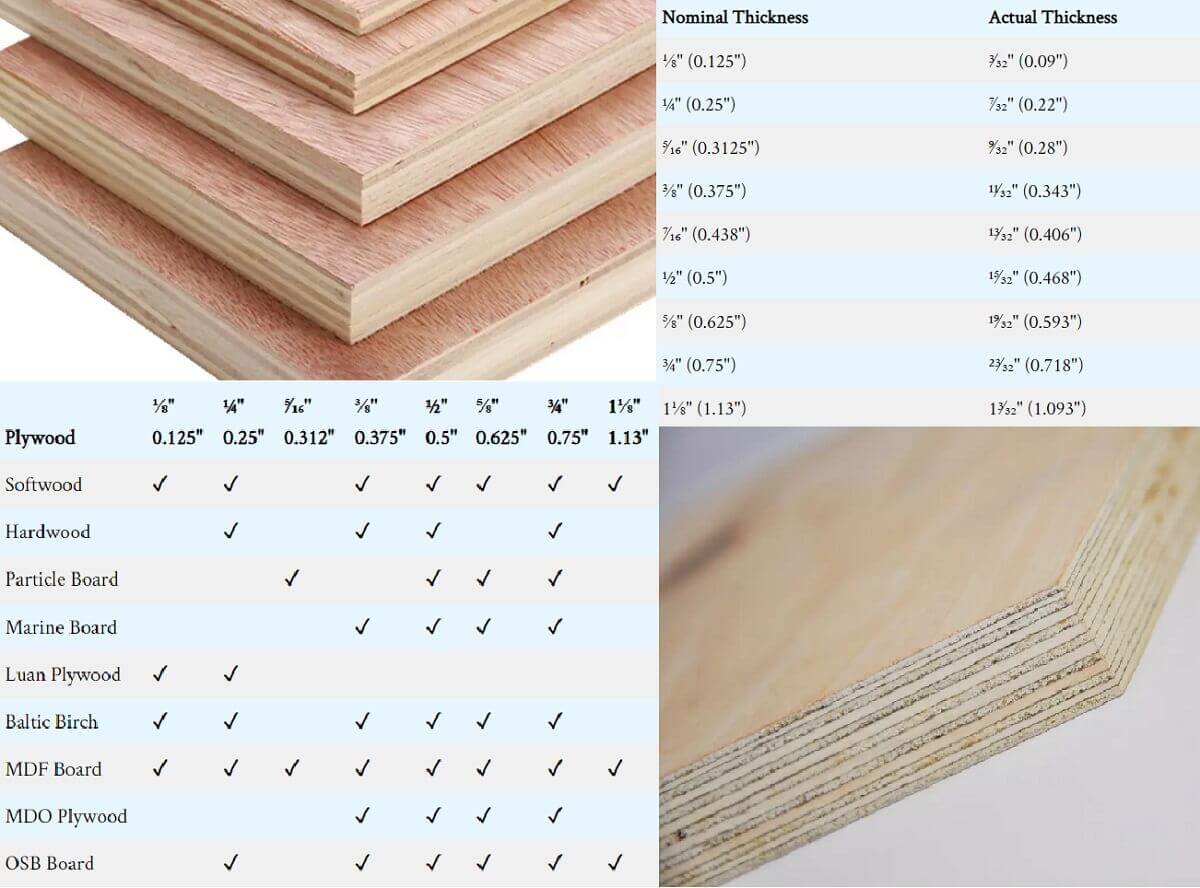If you’re wondering what size plywood to use for walls, you’re in the right place! Choosing the right plywood size is crucial for any wall project, whether you’re building a structure or renovating a room. Don’t worry, I’ve got you covered with all the information you need to make the right decision.
When it comes to plywood for walls, there are a few factors to consider. The thickness of the plywood is one of the most important aspects. Thicker plywood provides better structural support and durability, while thinner plywood is suitable for lighter applications. So, let’s dive into the different sizes of plywood and how they can be used for different wall projects.
Now that we’ve covered the basics, let’s explore the various sizes of plywood that are commonly used for walls. From 1/4 inch to 3/4 inch thickness, each size has its own strengths and uses. So, let’s get started and find the perfect plywood size for your wall project!

What Size Plywood for Walls? A Comprehensive Guide
When it comes to building or renovating walls, choosing the right size plywood is crucial for structural integrity and overall aesthetics. In this comprehensive guide, we will delve into the different factors to consider when determining the appropriate size plywood for walls. From understanding the various thickness options to exploring the benefits and tips, we’ve got you covered. Whether you’re a seasoned contractor or a DIY enthusiast, read on to ensure you make the right decision for your wall construction projects.
The Importance of Plywood Size for Walls
Before we delve into the specifics of plywood sizes for wall construction, it’s essential to understand why choosing the correct size is crucial. Plywood serves as a foundational material for walls, providing stability, strength, and a smooth surface for finishes such as paint or wallpaper. Choosing the wrong size can lead to structural issues, compromised durability, and difficulties during the installation process. By selecting the appropriate size plywood, you can ensure a sturdy and visually pleasing wall that will stand the test of time.
Factors to Consider When Choosing Plywood Sizes
1. Wall Thickness: The thickness of your walls will play a significant role in determining the appropriate plywood size. For interior walls, 1/2-inch or 5/8-inch plywood is often sufficient. However, for exterior walls or walls that require additional support, thicker plywood, such as 3/4-inch or 1-inch, may be necessary.
2. Stud Spacing: The spacing between the wall studs is another crucial factor to consider. Wall studs typically have standard spacing of 16 inches or 24 inches apart. To ensure proper support, the plywood should align with the stud spacing, allowing for secure attachment and even distribution of weight.
3. Building Codes: Depending on your location, there may be specific building codes and regulations that dictate the minimum requirements for plywood size in walls. It’s essential to consult local authorities or a building professional to ensure compliance with these standards.
Standard Plywood Sizes for Walls
When it comes to plywood for wall construction, several standard sizes are commonly used. The most commonly available sizes are 4 feet by 8 feet sheets, with thickness options ranging from 1/4 inch to 3/4 inch. Other sizes, such as 4 feet by 10 feet or 4 feet by 12 feet, are also available but may be less common and require special ordering. It’s important to consider the dimensions of your walls and the required thickness to determine the appropriate size sheet for your project.
Benefits of Choosing the Right Plywood Size for Walls
1. Enhanced Strength and Stability: By selecting the appropriate size plywood, you can ensure that your walls have the necessary strength and stability to withstand everyday wear and tear.
2. Easier Installation: When the plywood size aligns with the stud spacing, it makes the installation process smoother and more efficient. This reduces the risk of errors and minimizes the need for adjustments or modifications during construction.
3. Improved Aesthetics: Choosing the right plywood size for walls allows for a seamless finish and reduces the visibility of joints or gaps. This results in a visually appealing wall with a professional touch.
Tips for Choosing Plywood Sizes for Walls
1. Consult a Professional: If you’re unsure about the appropriate plywood size for your specific project, it’s always best to consult with a professional contractor or architect. They can assess the unique requirements of your wall construction and provide expert advice.
2. Consider Future Use: If you anticipate making changes or additions to your walls in the future, it’s wise to choose plywood sizes that can accommodate these modifications without compromising the overall integrity of the structure.
3. Quality Matters: When selecting plywood for walls, prioritize quality over price. Opt for plywood with adequate strength, durability, and resistance to moisture and pests. Investing in high-quality plywood will ensure the longevity and performance of your walls.
Plywood Sizes for Walls: A Comparison
| Size | Thickness (inches) | Common Uses |
|---|---|---|
| 4 ft x 8 ft | 1/4, 3/8, 1/2, 5/8, 3/4 | Interior walls, ceilings, and furniture |
| 4 ft x 10 ft | 1/2, 5/8, 3/4 | Large walls or projects requiring fewer seams |
| 4 ft x 12 ft | 3/4 | Commercial construction, larger walls or projects |
Additional Considerations for Plywood Sizes
Aside from the standard plywood sizes discussed above, there are a few additional considerations to keep in mind. If you require custom-sized plywood for specific wall dimensions, it’s often possible to have it cut at the lumberyard or using specialized cutting equipment. This allows for a precise fit and minimizes waste.
Furthermore, it’s essential to note that plywood sizes can vary slightly depending on the manufacturer or supplier. Therefore, it’s always advisable to measure and verify the dimensions of the plywood sheets before making a purchase. This ensures that you receive the correct size and minimizes the potential for errors during construction.
By following these guidelines and considering the factors mentioned above, you can confidently select the appropriate plywood size for your walls. Remember to prioritize quality, consult professionals when necessary, and keep your specific project requirements in mind. With the right plywood sizes, you can create walls that are structurally sound, visually appealing, and built to last.
Key Takeaways: What Size Plywood for Walls?
- 1. The ideal size for plywood used for walls is typically 4 feet by 8 feet.
- 2. This size is commonly available at most home improvement stores.
- 3. The thickness of the plywood may vary depending on the intended purpose and load-bearing requirements.
- 4. Common thickness options are 1/2 inch, 5/8 inch, and 3/4 inch.
- 5. It’s important to consult local building codes or a professional to determine the appropriate plywood size and thickness for your specific project.
Frequently Asked Questions
Looking to find the right size plywood for your walls? Check out these common questions.
1. What should be the thickness of plywood for wall installations?
When it comes to installing plywood for walls, a thickness of 3/8 or 1/2 inch is typically recommended. This thickness provides enough durability and stability to support your walls without adding unnecessary weight or cost. Thicker plywood may be used for specific scenarios or if you’re looking for additional insulation or soundproofing.
Keep in mind that the thickness of plywood will depend on factors such as the distance between studs, the type of material you’ll be attaching to the plywood, and the overall purpose of the wall. Consulting with a professional or following local building codes can help you determine the appropriate plywood thickness for your specific project.
2. Can I use thinner plywood for non-load-bearing walls?
Yes, you can use thinner plywood, such as 1/4 or 3/8 inch, for non-load-bearing walls. Non-load-bearing walls are not responsible for supporting the weight of the structure, so they do not require as much structural strength. Thinner plywood can still provide the necessary surface for attaching drywall or other wall finishes.
However, it’s important to ensure that the thickness of the chosen plywood is suitable for the specific purpose and local building codes. Thinner plywood may not be suitable for certain applications, such as areas prone to moisture or high-impact areas. Consulting with a professional or doing thorough research is recommended.
3. Do I need to use plywood for all walls?
Not necessarily. It depends on the specific requirements and design of your project. Plywood is commonly used in construction for its strength and durability, but it may not be necessary for every wall. Load-bearing walls or walls that need extra support for heavy fixtures or appliances often require plywood.
Non-load-bearing interior walls or walls in areas with minimal stress may not require plywood. In some cases, drywall alone is sufficient. It’s important to consult local building codes and professionals to determine whether plywood is necessary for your specific project.
4. Can I use plywood as a finished wall surface?
While plywood can be used as a finished wall surface, it may not provide the desired aesthetic for certain projects. Plywood has a distinctive grain and appearance, which may not be suitable for a smooth and polished finish. However, there are ways to enhance the look of plywood by painting, staining, or applying veneers.
If you prefer a traditional drywall finish, you can attach drywall over the plywood for a smooth surface. This allows you to enjoy the strength and stability of plywood while achieving a more standardized wall appearance. Ultimately, the choice between using plywood as a finished surface or covering it with another material depends on your design preferences and project requirements.
5. What other considerations are important when using plywood for walls?
While choosing the right size of plywood is crucial, there are other factors to consider when using plywood for walls. One important consideration is the quality of the plywood. Look for plywood that is free of defects, such as warping or delaminations, to ensure a sturdy and long-lasting installation.
You should also consider the moisture resistance of the plywood. If you’re installing plywood in areas prone to moisture, such as bathrooms or kitchens, make sure to use plywood that is specifically designed for such environments. Additionally, proper installation techniques, such as securing the plywood to studs and using the appropriate fasteners, play a crucial role in the overall performance and durability of the walls.

Summary
Choosing the right size plywood for walls is important for a strong and durable structure. The thickness of the plywood should be at least 1/2 inch for interior walls and 3/4 inch for exterior walls. Plywood with a smooth surface is recommended for easy installation and finishing. It is also important to consider the size of the plywood sheets to minimize the number of seams on the walls.
Additionally, plywood with a higher grade, such as A or B, is preferable as it has fewer flaws and is more resistant to warping. It is important to ensure that the plywood is properly attached to the wall studs using nails or screws. Overall, selecting the right size and quality of plywood will help create sturdy and long-lasting walls for your home.
